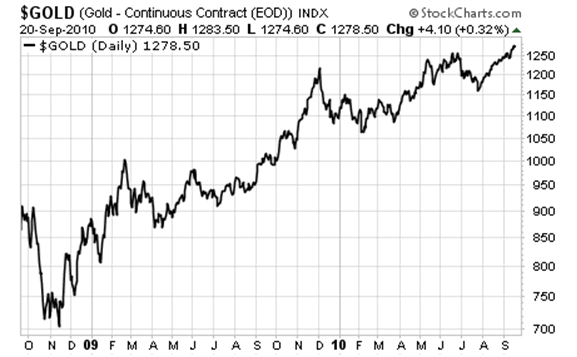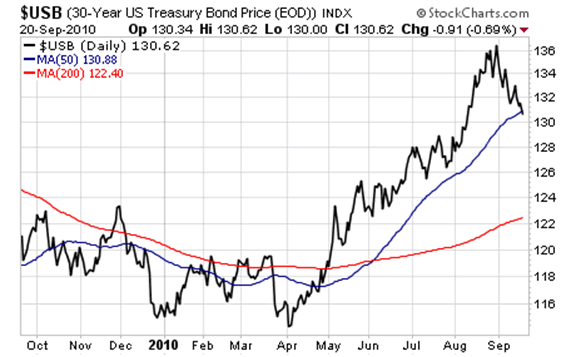U.S. Debt Options of Default or Hyperinflation
Interest-Rates / US Debt Sep 29, 2010 - 04:08 AM GMTBy: Graham_Summers
 The big financial myth-buster of the week is that the alleged deleveraging of the US consumer has in fact been a giant myth. According to the Wall Street Journal, if you account for defaults, US consumers have only pared down their debts by an annual rate of 0.8% since mid-2008.
The big financial myth-buster of the week is that the alleged deleveraging of the US consumer has in fact been a giant myth. According to the Wall Street Journal, if you account for defaults, US consumers have only pared down their debts by an annual rate of 0.8% since mid-2008.
The Journal writes (emphasis added):
Over the two years ending June 2010, the total value of home-mortgage debt and consumer credit outstanding has fallen by about $610 billion… Our own analysis of data from the Fed and the Federal Deposit Insurance Corp. suggests that over the two years ending June 2010, banks and other lenders charged off a total of about $588 billion in mortgage and consumer loans.
That means consumers managed to shave off only $22 billion in debt... In other words, in the absence of defaults, they would have achieved an annualized decline of only 0.08%.
This is a major deal-changer for the US financial system. For months we’re been hearing tales of consumers are doing the right thing by paying off debts and living more frugally. While this is true for some consumers, the Journal’s article makes it clear that the vast majority of folks are simply spending until they’re officially bust and have their credit lines pulled.
Whether this is because Americans are stuck on a “buy ‘til you’re bust” mania, or if it’s simply because the cost of living in the US today is so high relative to incomes and other expenses that most folks can’t get by without using credit is up for debate.
Personally I think it’s a bit of both, with some folks obsessively buying the new iPad while skipping on mortgage payments while others are simply using credit cards to try and get by after being unemployed or underemployed.
Indeed, another story run in the Wall Street Journal supporting the second argument points out that incomes have actually fallen 4.9% since 2000. Add to this the $1.5 trillion drop in household wealth in 2Q10 and it’s clear US consumers are making less and losing even more from their investments.
This leaves credit as the one means of maintaining living standards.
Regardless, the primary point is that the US credit bubble has not deleveraged in any meaningful way. The system remains debt saturated to the gills on a personal, corporate, state, and Federal level.
In plain terms, the entire US system is one giant debt bubble. And there are only three ways to deal with a debt problem:
- Pay it back
- Default/ restructure
- Hyper-inflate it away
The US has no chance of #1, which leaves either #2 or #3. Both involve the Dollar taking a sizable hit, which might explain why Gold has begun breaking out while Treasuries are dipping.


Keep your eyes on these two, if they don’t reverse soon then something big is coming down the pike for the Dollar.
Good Investing!
Graham Summers
PS. If you’re worried about the future of the stock market, I highly suggest you download my FREE Special Report detailing SEVERAL investments that could shelter your portfolio from any future collapse. Pick up your FREE copy of The Financial Crisis “Round Two” Survival Kit, today at: http://www.gainspainscapital.com/MARKETING/roundtwo.html
Graham Summers: Graham is Senior Market Strategist at OmniSans Research. He is co-editor of Gain, Pains, and Capital, OmniSans Research’s FREE daily e-letter covering the equity, commodity, currency, and real estate markets.
Graham also writes Private Wealth Advisory, a monthly investment advisory focusing on the most lucrative investment opportunities the financial markets have to offer. Graham understands the big picture from both a macro-economic and capital in/outflow perspective. He translates his understanding into finding trends and undervalued investment opportunities months before the markets catch on: the Private Wealth Advisory portfolio has outperformed the S&P 500 three of the last five years, including a 7% return in 2008 vs. a 37% loss for the S&P 500.
Previously, Graham worked as a Senior Financial Analyst covering global markets for several investment firms in the Mid-Atlantic region. He’s lived and performed research in Europe, Asia, the Middle East, and the United States.
© 2010 Copyright Graham Summers - All Rights Reserved
Disclaimer: The above is a matter of opinion provided for general information purposes only and is not intended as investment advice. Information and analysis above are derived from sources and utilising methods believed to be reliable, but we cannot accept responsibility for any losses you may incur as a result of this analysis. Individuals should consult with their personal financial advisors.
Graham Summers Archive |
© 2005-2022 http://www.MarketOracle.co.uk - The Market Oracle is a FREE Daily Financial Markets Analysis & Forecasting online publication.



